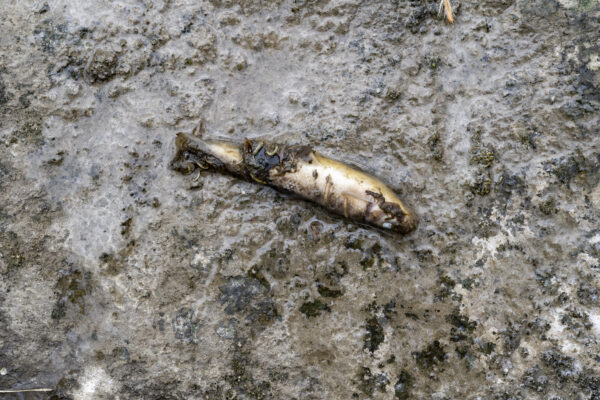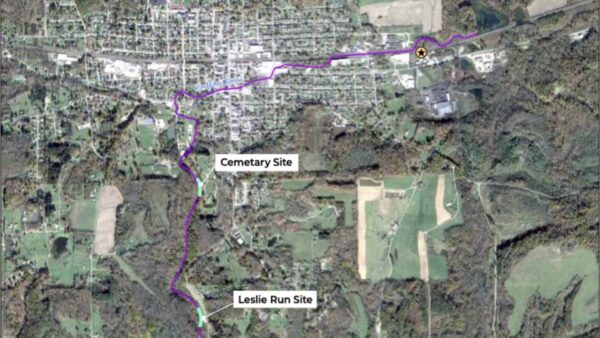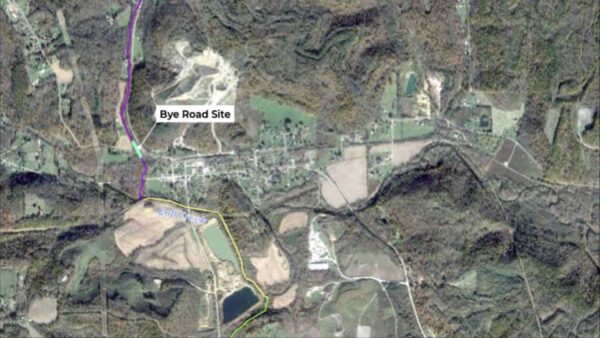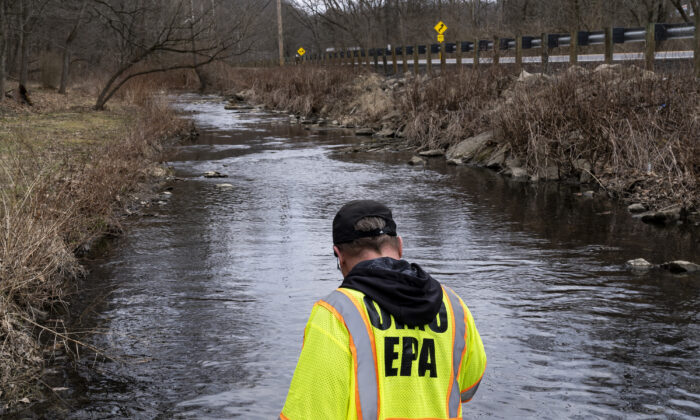Ron Fodo, Ohio EPA Emergency Response, looks for signs of fish and also agitates the water in Leslie Run creek to check for chemicals that have settled at the bottom following a train derailment that is causing environmental concerns in East Palestine, Ohio, on Feb. 20, 2023. (Michael Swensen/Getty Images)
The number of wildlife estimated to have been killed in the wake of the Ohio train derailment is nearly 44,000, less than officials first thought, according to the Ohio Department of Natural Resources (ODNR).
Although dead animals remain in the affected waterways, ODNR Director Mary Mertz noted in an update Thursday that live fish have returned to some parts of the area.
The updated figure includes around 38,222 minnows and approximately 5,500 other water creatures, such as fish, crayfish, and amphibians, within a five-mile radius of the crash site in the town of East Palestine.
The impact on other non-aquatic wildlife, including three birds and an opossum, are still being investigated.
The survey was conducted over two days on Feb. 6 and 7 by EnviroScience, an environmental consulting firm, under the direction of the Division of Wildlife, using standard scientific methods, according to ODNR.

Mertz said the agency sought the help of EnviroScience, which was already on-site to contain the spill, after ODNR personnel arrived directly after the incident and were told by the Ohio EPA that it was too dangerous to enter the water without specialized gear and equipment.
The Norfolk Southern train was transporting dangerous chemicals such as vinyl chloride, hydrogen chloride, and other hazardous materials when it derailed on Feb. 3 en route to Pennsylvania.
Officials said crews burned off the hazardous chemicals in a “controlled release” to avoid a potential explosion. This resulted in a plume of black smoke, leading to concerns about the effect on the environment, including the air, land, and water quality in the immediate vicinity.
Locals were urged to evacuate their homes during the burn off, but some people reported health reactions like rashes, nausea, and headaches upon return. Some also reported that the area’s animals, including livestock, were getting sick or dying.
Officials from the Environmental Protection Agency have said the agency has been monitoring air quality in the area and hasn’t detected any hazardous risks. However, some residents remain skeptical.
The impacted environment spans 5 miles of waterway from the derailment site to the point where Bull Creek flows into the north fork of Little Beaver Creek, according to ODNR.
Survey Method
Mertz explained that the scientific approach to investigating fish kill in a watershed involves collecting data and specimens promptly, “which is what happened.”
The survey was conducted over two days from Feb. 6 to 7. The controlled release of chemicals occurred on Feb. 6.
“Four collection stations were established to gather necessary data, in this case dead aquatic species,” Mertz said. “We had 2–3 officers monitoring that collection since it began. Dead fish were collected in the four designated survey spots by entering the water and using a net.”
“Following collection, EnviroScience counted, identified, measured, and arranged disposal of the aquatic species to limit impact to other wildlife that might feed on affected aquatic species,” she continued.
Their final sample count found 2,938 aquatic species killed in waterways, mostly small minnows (2,200) that ranged in size from 1 to 3 inches. This figure is lower than the 3,500 original investigators estimated based on visual observations immediately after the crash.


Based on this count, ODNR wildlife investigators used a calculation endorsed by the American Fisheries Society to estimate the total number of minnows killed.
“The investigation has thus far concluded that of the 7-and-a-half-mile impacted area, the species were killed over a 5-mile span,” Mertz said.
According to Mertz, the impact to aquatic life is believed to have occurred in the first 24 hours after the derailment. She noted that ODNR officers checked the Ohio River through Jefferson County and at the Cumberland lock and dam and had not observed “any dead aquatic life.”
“And, it’s important to stress that these small fish are all believed to have been killed immediately after the derailment,” Mertz said. “Because the chemicals were contained, ODNR has not seen any additional signs of aquatic life suffering in the streams. In fact, we have seen live fish return to Leslie Run.”
She noted that none of the species killed are believed to be endangered or threatened.
https://www.theepochtimes.com/officials-release-update-on-wildlife-killed-by-ohio-train-derailment_5080268.html?ea_med=desktop_news&tmp=1&ea_src=ai_recommender



No comments:
Post a Comment